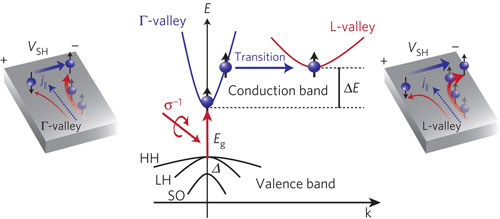| Posted: Aug 12, 2014 |
Electric control of the spin-Hall effect
|
|
(Nanowerk News) Research published in the journal Nature Materials ("Electric control of the spin Hall effect by intervalley transitions") reports the discovery of a new method to control the spin-Hall effect in semi-conducting materials. Working with an international team of scientists, the study by lead author Hidekazu Kurebayashi of the LCN offers a radical way of developing a new generation of electronic devices capable of harnessing the magnetic properties of electrons.
|
 |
| GaAs electronic structure, inter-valley transition process and spin-Hall effect. Optically generated spin-polarised electrons are transferred to the L-valley by an electric field, inducing a large spin-Hall effect.
|
|
Current electronic devices work with transistors that depend on the flow of electric charge currents. For several decades now these have become ever smaller, following Moore’s law – the observation that computer processing power doubles every two years. However, once the size of transistors approaches scale of atoms this trend will have to come to an end as no further reductions in size are possible. Hence scientists are searching for fundamentally new concepts in electronics that make it possible develop greater processing power at ever smaller scales.
|
|
Spintronics – an approach that exploits the tiny magnetic moment (‘spin’) of the electron – is an approach that promises to outperform the current charge-based technology for the storage and processing of information. Researchers have identified the spin-Hall effect, a method of generating ‘spin currents’ which enable spin information transfer without the flow of electric charge currents, as a potentially efficient method of generating spins so that devices can operate efficiently with low power consumption. Spin current can transfer information without Joule heating – the heat released by the transfer of an electric charge, a serious problem in current semiconductor devices – as well as offering the prospect of revolutionising memory applications.
|
|
The research published by Dr. Kurebayashi and an international research team of scientists from University College London (UCL) and University of Cambridge in the UK, Mainz University in Germany, the Institute of Physics of the Academy of Sciences in Czech Republic, and Tohoku University in Japan, is a breakthrough in the field. Applying a large electric field to Gallium Arsenide (GaAs), the research team was able to exploit the ‘Gunn effect’, a non-linear means to transport electrons. Electrons “hop” between sections, or valleys, in GaAs, each with unique carrier transport properties. Using these differences between valleys as well as the spin-orbit properties of electrons, the team was able to control the spin-Hall effect. They observed it at 40 times greater than the measurement previously achieved in GaAs, which is comparable to the highest value seen in heavy metals such as platinum.
|
|
As Dr. Kurebayashi explained, the results were obtained using familiar technology: “We borrow 50-year-old semiconductor phenomena for our modern spintronic research. Our results are the start of the story but are a proof of principle with a promising future for spins.”
|
|
The results are a proof of principle, and the expectation is that similar results will eventually be produced in comparable materials. From a long-term perspective, Dr. Kurebayashi indicated that these results also hold out the prospect of replacing the use of heavy metals with other, cheaper materials in future electronic devices. “As we have limited amount of natural resources in the earth and prices of materials are progressively going up, we need to find more accessible materials with which to develop future sustainable technologies, hopefully based on electron spin rather than charge.”
|

